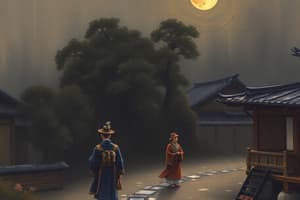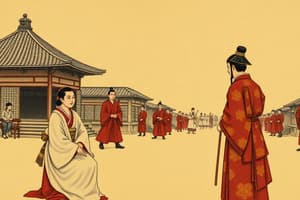Podcast
Questions and Answers
What is the capital of Japan?
What is the capital of Japan?
- Tokyo (correct)
- Yokohama
- Osaka
- Kyoto
How many islands make up the Japanese archipelago?
How many islands make up the Japanese archipelago?
- 30,000
- 6852 (correct)
- 145,937
- 377,975
What period saw the emergence of a Japanese state centered on the Imperial Court?
What period saw the emergence of a Japanese state centered on the Imperial Court?
- Upper Paleolithic
- Nara (correct)
- Meiji
- Jinshin
What was the main purpose of the Taihō Code?
What was the main purpose of the Taihō Code?
Who issued the Meiji Constitution in 1890?
Who issued the Meiji Constitution in 1890?
Flashcards are hidden until you start studying
Study Notes
- Japan is an island country in East Asia.
- It is bordered on the west by the Sea of Japan, while extending from the Sea of Okhotsk in the north toward the East China Sea, Philippine Sea, and Taiwan in the south.
- Japan is a part of the Ring of Fire, and spans an archipelago of 6852 islands covering 377,975 square kilometers (145,937 sq mi); the five main islands are Hokkaido, Honshu (the "mainland"), Shikoku, Kyushu, and Okinawa.
- Tokyo is the nation's capital and largest city, followed by Yokohama, Osaka, Nagoya, Sapporo, Fukuoka, Kobe, and Kyoto.
- Japan is the eleventh most populous country in the world, as well as one of the most densely populated and urbanized.
- About three-fourths of the country's terrain is mountainous, concentrating its population of 123.2 million on narrow coastal plains.
- Japan is divided into 47 administrative prefectures and eight traditional regions.
- The Greater Tokyo Area is the most populous metropolitan area in the world, with more than 35.6 million residents.
- Japan has been inhabited since the Upper Paleolithic period (30,000 BC), though the first written mention of the archipelago appears in a Chinese chronicle (the Book of Han) finished in the 2nd century AD.
- Between the 4th and 9th centuries, the kingdoms of Japan became unified under an emperor and the imperial court based in Heian-kyō.
- Political power was held by a series of military dictators (shōgun) and feudal lords (daimyō) and enforced by a class of warrior nobility (samurai).
- After a century-long period of civil war, the country was reunified in 1603 under the Tokugawa shogunate, which enacted an isolationist foreign policy.
- In 1854, a United States fleet forced Japan to open trade to the West, which led to the end of the shogunate and the restoration of imperial power in 1868.
- In the Meiji period, the Empire of Japan adopted a Western-modeled constitution and pursued a program of industrialization and modernization.
- Amidst a rise in militarism and overseas colonization, Japan invaded China in 1937 and entered World War II as an Axis power in 1941.
- After suffering defeat in the Pacific War and two atomic bombings, Japan surrendered in 1945 and came under a seven-year Allied occupation, during which it adopted a new constitution and began a military alliance with the United States.
- Under the 1947 constitution, Japan has maintained a unitary parliamentary constitutional monarchy with a bicameral legislature, the National Diet.
- Japan is a developed country, member of OECD, and a great power.
- Its economy is the world's
- The Japanese archipelago was first inhabited by Paleolithic people.
- The Japonic-speaking Yayoi people began to enter the archipelago from the Korean Peninsula in the 6th century.
- Buddhism was introduced to Japan from Baekje in 552 and became popular among the ruling class.
- The far-reaching Taika Reforms of 645 nationalized all land in Japan and ordered the compilation of a household registry.
- The Jinshin War of 672 led to administrative reforms.
- The Nara period marked the emergence of a Japanese state centered on the Imperial Court in Heijō-kyō.
- The period is characterized by the emergence of a nascent literary culture and the completion of the Kojiki and Nihon Shoki.
- A smallpox epidemic in 735–737 killed as much as one-third of Japan's population.
- In 784, Emperor Shōmu issued the Taihō Code, which consolidated existing statutes and established the structure of the central and subordinate local governments.
- Japan's feudal era was characterized by the emergence and dominance of a ruling class of warriors, the samurai.
- In 1185, following the defeat of the Taira clan in the Genpei War, samurai Minamoto no Yoritomo established a military government at Kamakura.
- After Yoritomo's death, the Hōjō clan came to power as regents for the shōgun.
- The Zen school of Buddhism was introduced from China in the Kamakura period and became popular among the samurai class.
- The Kamakura shogunate repelled Mongol invasions in 1274 and 1281 but was eventually overthrown by Emperor Go-Daigo.
- Go-Daigo was defeated by Ashikaga Takauji in 1336, beginning the Muromachi period.
- The succeeding Ashikaga shogunate failed to control the feudal warlords (daimyō) and a civil war began in 1467, opening the century-long Sengoku period.
- In 1854, Commodore Matthew C. Perry and the "Black Ships" of the United States Navy forced the opening of Japan to the outside world.
- Subsequent similar treaties with other Western countries brought economic and political crises.
- The resignation of the shōgun led to the Boshin War and the establishment of a centralized state nominally unified under the emperor.
- Adopting Western political, judicial, and military institutions, the Cabinet organized the Privy Council, introduced the Meiji Constitution (29 November 1890), and assembled the Imperial Diet.
- During the Meiji period (1868–1912), the Empire of Japan emerged as the most developed nation in Asia and as an industrialized world power that pursued military conflict to expand its sphere of influence.
- After victories in the First Sino-Japanese War (1894–1895) and the Russo-Japanese War (1904–1905), the Meiji government pursued a policy of "opening up" Japan to the world through initiatives such as the 1894 Imperial University Act and the 1899 Education Reform Act.
- The Meiji period saw a period of modernization and growth for Japan.
- During World War II, Japan invaded other parts of Asia, precipitating the Second Sino-Japanese War.
- After Allied victories during the next four years, Japan signed an unconditional surrender.
- The Meiji period saw a shift towards statism, a period of lawlessness following the 1923 Great Tokyo Earthquake.
- In 1947, Japan adopted a new constitution emphasizing liberal democratic practices.
- The Allied occupation ended with the Treaty of San Francisco in 1952.
- In 1956, Japan became a member of the United Nations.
- In the mid-1990s, Japan suffered a period of economic decline.
- On March 11, 2011, Japan suffered one of the largest earthquakes in its recorded history.
- On May 1, 2019, after the historic abdication of Emperor Akihito, his son Naruhito became Emperor, beginning the Reiwa era.
Studying That Suits You
Use AI to generate personalized quizzes and flashcards to suit your learning preferences.




